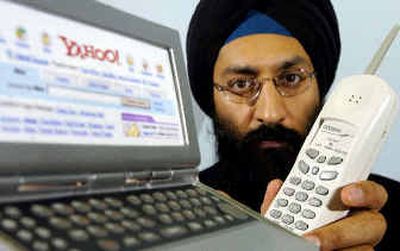A new calling

First of a three-part series
SAN JOSE, Calif. — Before business trips, Suneet Tuli used to leave behind a long list of numbers where he could be reached and told important clients to ring him on his cell phone. The routine was cumbersome and cost him about $800 a month in phone bills.
Now, he has local numbers for New York, London and Mexico City despite no permanent presence in any of those cities. The lines automatically forward to another number that seamlessly transfers to a cell phone with the best rates for wherever he happens to be.
Because Tuli’s calls are routed mainly over the Internet instead of the traditional voice network, he can make changes to the elaborate setup simply by visiting a Web site. And he’s cut his phone bill by about 80 percent.
“Even though it seems a little complicated, in my mind it’s all straight,” said Tuli, chief executive of DataWind Inc., a Montreal company that makes handheld Internet-browsing devices.
Tuli is in the Voice-over-Internet vanguard, relying ever more on a technology that is transforming what it means to make a phone call by converting our conversations into little packets of data that traverse the Internet.
After a decade of promises about how it would forever change communications, Voice over Internet Protocol, or VoIP, is finally beginning to nudge the 130-year-old traditional phone network toward obsolescence.
It’s inexpensive and, beyond mimicking traditional telephony, makes possible a wide range of new digital revolution-bestowing features and flexibility that people like Tuli are seizing on.
Yet the fact that Voice over Internet relies on data networks is both its greatest strength and biggest liability. Because it piggybacks on top of existing services, companies offering it need not dig up streets, roll trucks to homes or pay the same amount of regulatory fees as traditional telcos.
VoIP’s amazing features and low costs come paired with questions of reliability and regulation that the industry and government are only beginning to address. And you need a broadband Internet connection, which is far from ubiquitous though more than half of U.S. households that go online now have one.
Mainly marketed as a supplement or replacement for traditional phones, VoIP is already used by millions worldwide, most of them in Japan. In the United States, the numbers are expected to grow from about 3 million today to some 27 million by 2008, according to the research firm IDC.
Vonage Holdings Corp., Tuli’s VoIP provider, now serves more than 600,000 customers, adding 200,000 so far this year. And Skype, a European-based phenomenon that offers free PC-to-PC calling, says more than 2 million people use its service at any moment.
In just six months, Cisco Systems Inc.’s Linksys sold 1 million Internet phone kits that turn broadband connections into Internet phone jacks — a pace that beat the past launches of home routers and Wi-Fi devices.
VoIP startups with names like BroadVoice, SunRocket and VoicePulse now number in the dozens, joining market leader Vonage. Cable companies and traditional telephone companies are also scrambling for your VoIP business. Even standalone Internet providers such as America Online Inc. are jumping into the game.
In Voice over Internet’s early days, hobbyists with microphones plugged into their PCs used to gab with other geeks. Reliability was shaky, call quality even worse.
Now, Voice over Internet users can chat through conventional telephones, paying about $20 to $30 a month for unlimited domestic long distance and add-ons that would cost extra in the traditional phone system. Most importantly, they can call, and receive calls from, the traditional phone system.
“As more homes have broadband, the odds are the user market will go up in proportion,” said Jeff Pulver, an Internet telephony pioneer. “The question is who becomes the dominant providers: Is it going to be the incumbent cable operators, the incumbent phone companies or start-ups?”
Whether there’s a broad public appetite for this newfangled phonery remains unclear. Are current VoIP offerings attractive enough for people to want to unplug their reliable traditional phones for generally cheaper but more unreliable Internet telephones? A lot more convenience can be built into the technology.
Tuli says the quality of the VoIP calls has improved dramatically since he first tested out Internet telephony.
“Today, most people who call me have no idea,” he says.
But reliability is a major issue for some who have switched. Because the calls ride over broadband connections, the phone is only as reliable as that service. And Internet phone companies have had their share of service outages.